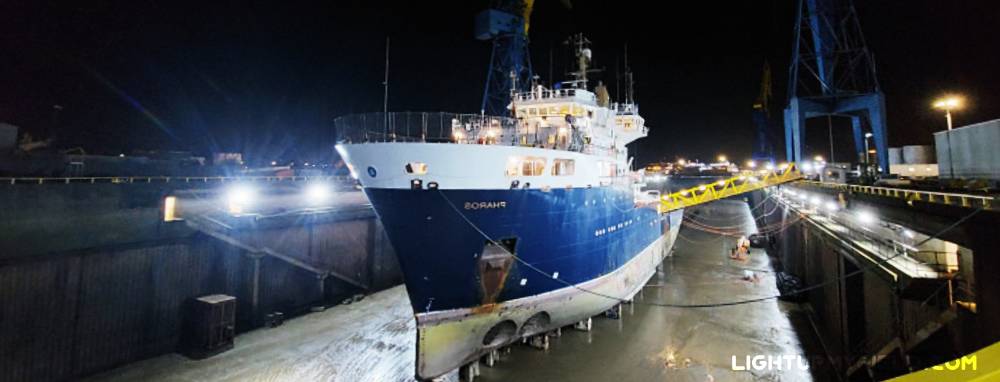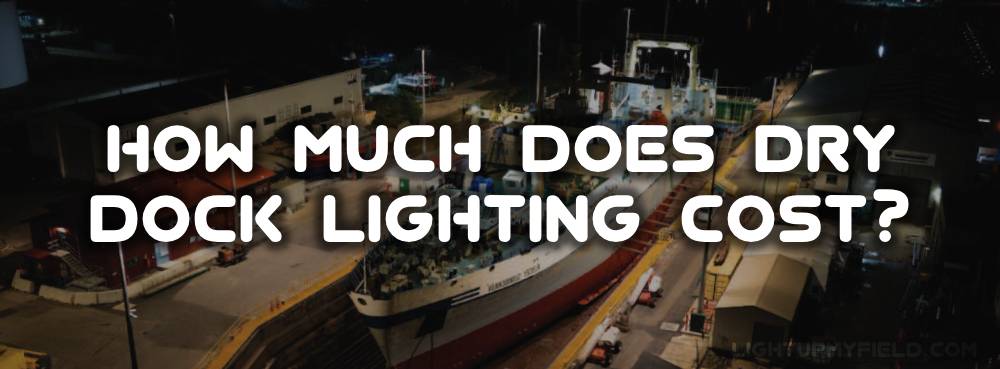Dry docks are massive, complex, and often run around the clock. Proper illumination makes the work safer and more efficient, but it also comes with a price tag. So, how much should you really expect to spend when setting up or upgrading a dry dock lighting system?
Let’s break it down into actual numbers and the factors that make costs go up or down. We’ll also look at ways to offset expenses through funding or rebates.
Table of Contents
ToggleAverage Cost of Dry Dock Lighting
When someone asks about the price tag for dry dock lighting, there’s no single number that fits all. The overall cost usually falls into four big buckets: the price of the lights themselves, what it costs to run them, installation expenses, and ongoing maintenance. Each one plays a part in the total.
Light Fixture Costs
The lights are where everything begins. For dry docks, you’ll usually be dealing with high-power LED floodlights—they’re bright, tough, and built for demanding environments. A quality LED fixture made for industrial use typically runs anywhere from $400 up to $1,200 per unit, depending on wattage, housing quality, and extras like smart controls or marine-grade coatings to fight corrosion.
Take a 500-watt LED floodlight as an example—that’s a common size for these setups. Expect to pay around $600 to $800 per fixture for something reliable. If your dry dock needs 50 fixtures, that’s already $30,000 to $40,000 just for the lights. Double that to 100 fixtures for a large facility, and you’re easily crossing $70,000 before you’ve even touched installation.

Running Costs
After the upfront spend, the next cost that kicks in is energy. The good news is that LEDs use 50–70% less electricity than old-school metal halide or high-pressure sodium lamps, but you’re still powering serious brightness.
Here’s what the math looks like: a 500W LED running 12 hours a day at an electricity rate of $0.12 per kWh costs about $0.06 an hour. Multiply by 12 hours, and that’s $0.72 a day per light. Over a year (365 days), one fixture racks up roughly $262 in electricity costs.
Now scale that across 50 fixtures, and your annual energy bill comes in around $13,000. Go to 100 fixtures, and you’re talking about $26,000 a year—and that’s assuming energy prices stay stable.
Installation Costs
This is the part that often catches people off guard. Mounting and wiring these lights isn’t as simple as swapping out a bulb. Dry docks usually require high-mast poles, rugged mounting brackets, and sometimes custom solutions for cranes or heavy-lift areas.
If you’re setting up high masts, installation costs per pole can range from $300 to $1,000, and that’s before labor for wiring. If cranes or scaffolding are needed for the job, costs can shoot up to $2,000 per pole. Need to upgrade old electrical infrastructure to handle the new load? Add another $10,000 to $20,000 to your budget.
Maintenance Costs
LEDs don’t need much attention compared to older lamps, but they’re not maintenance-free. You’ll still have to clean lenses, check seals, and occasionally replace drivers or fixtures that fail. A good rule of thumb: budget about 1–2% of your total system cost per year for upkeep.
So, if your lighting system costs $100,000, set aside $1,000 to $2,000 annually for cleaning, inspections, and the occasional repair. It’s not a huge number, but it’s worth planning for—especially in salty, humid environments where corrosion can creep in over time.
| Cost Category | Typical Range | Example / Notes |
|---|---|---|
| Light Fixture Cost | $400 – $1,200 per fixture | 500W LED: $600 – $800 each |
| Total Fixtures Needed | 50 to 100 fixtures | 50 fixtures: $30,000 – $40,000; 100 fixtures: $70,000+ |
| Running Cost (Energy) | ~$0.72 per fixture per day | 500W LED @ 12 hrs/day, $0.12/kWh = $262/year per fixture |
| Annual Energy Cost | $13,000 (50 fixtures) to $26,000 (100 fixtures) | |
| Installation Cost | $300 – $1,000 per pole (up to $2,000 if complex) | Additional $10,000 – $20,000 for wiring upgrades |
| Maintenance Cost | 1–2% of total system cost per year | $1,000 – $2,000/year for a $100,000 system |
What Affects the Lighting Cost?
Not every dry dock lighting job comes with the same price tag. In fact, costs can swing wildly depending on several factors that go way beyond just the number of fixtures. Let’s break down what really drives the budget up—or keeps it in check.
Size and Layout of the Dry Dock

First thing’s first: bigger spaces cost more to light. No surprise there. But it’s not only about square footage—layout plays a huge role too. A long, narrow dock often needs a different setup than a wide, open basin. Narrow areas might require fixtures with tighter beam angles to avoid wasting light, while wider docks usually call for broader coverage.
Then there’s mounting height. If your poles are 30 meters tall, you might get away with fewer fixtures because each light covers more ground. But here’s the catch: higher mounting means stronger poles, sturdier foundations, and more powerful (a.k.a. more expensive) lights to maintain brightness at ground level. So while fewer poles sounds good, the added cost of stronger infrastructure can balance things out.
For example, lighting a 50,000-square-meter dock with 30-meter poles might take 60 to 80 high-output fixtures, each delivering upwards of 100,000 lumens, whereas a lower pole design could require 90 or more smaller fixtures. Same brightness, different layout—and different cost dynamics.
Lighting Standards and Brightness Requirements
What you do in the dry dock has a big impact on what you need. If you’re working on detailed welding or hull inspections, you’re looking at illumination levels around 150 lux or even higher in work zones. That means more fixtures or higher wattage LEDs, which both drive up costs.
On the other hand, for general activities like moving cargo or basic maintenance, 50–100 lux might do the job. So if your operations don’t demand pinpoint precision, you can save a lot by dialing back the brightness requirements.
To put numbers on it: reaching 150 lux across a large dry dock could require 20–30% more fixtures than a setup designed for 75 lux. That’s tens of thousands of dollars extra right there.
Fixture Quality and Features
Here’s a spot where cutting corners often backfires. Cheap LEDs may look like a win on day one, but if they start dimming after 12 months or fail under salt exposure, you’ll be paying again—plus the labor cost of swapping them out.
High-quality industrial LEDs usually have:
- IP66 or higher weatherproofing to block out water and dust
- Marine-grade powder coating for corrosion resistance
- Lifespans rated at 50,000 to 100,000 hours, which can mean 10+ years in real use
These features cost more upfront, but the payoff is fewer headaches later. Then there are the bells and whistles like smart controls, dimming options, and remote monitoring. Yes, they add to the purchase price—sometimes 10–20% more—but the savings in energy and maintenance often outweigh that over time.
Environmental Challenges
Dry docks are not gentle environments. We’re talking salt spray, high humidity, temperature swings, and constant vibration from heavy machinery. All of that beats up on your lighting system.
If you’re in a coastal zone with salty air, you’ll want lights designed with extra corrosion protection. These premium-grade fixtures might cost 15–25% more, but skipping that step means you’ll be replacing lights much sooner—sometimes in just a couple of years. That’s a lot more expensive than paying for quality up front.
How to Apply for Funding
 The good news? You don’t always have to pay the full cost of a lighting upgrade out of pocket. There are actually several ways to get financial help for retrofitting your dry dock with LEDs, and some of these programs can take a big chunk out of your project costs.
The good news? You don’t always have to pay the full cost of a lighting upgrade out of pocket. There are actually several ways to get financial help for retrofitting your dry dock with LEDs, and some of these programs can take a big chunk out of your project costs.
Government Energy-Efficiency Programs
One of the easiest places to start is with energy-efficiency rebate programs. A lot of local and national governments are pushing businesses to cut energy consumption, and LEDs are one of the fastest ways to do that.
Depending on your region, you could qualify for cash rebates or tax incentives that cover anywhere from 10% to 30% of the total project cost. For a $100,000 lighting project, that’s potentially $10,000 to $30,000 back in your pocket.
Utilities often run their own incentive programs too. For example, some providers give direct cash incentives based on kWh savings. If your new LED system will save 200,000 kWh per year, and the utility pays $0.05 per kWh saved, that’s another $10,000 incentive—and that’s before you even factor in your reduced energy bills.
Maritime and Industrial Grants
Don’t forget about sector-specific programs. Many countries and port authorities have funding initiatives designed to modernize maritime infrastructure. Lighting might not be the star of the show, but it often qualifies under broader energy-efficiency or safety improvement programs.
The tricky part? These grants aren’t always well-publicized. The best way to find them is to reach out to local maritime authorities, trade associations, or port management offices. Sometimes, they even have grant writers or consultants who can guide you through the application process.
Carbon Reduction Initiatives
If your shipyard has sustainability targets or ESG (Environmental, Social, and Governance) reporting obligations, upgrading to LEDs can do more than save energy—it can help you tap into green financing options.
Some programs offer low-interest loans or performance-based incentives for projects that lower carbon emissions. And let’s not forget carbon credits. While you won’t usually get cash upfront, reducing your CO₂ output can generate tradable credits or improve your compliance score for future tenders.
For context, swapping out 100 metal halide fixtures for LEDs could cut your annual electricity use by 250,000 kWh, which translates to roughly 175 metric tons of CO₂ avoided (based on typical emission factors). That’s a figure you can leverage when applying for green programs.
How to Get Started
Here’s where a lot of people stumble: documentation. Every funding body wants proof that your project will actually save energy and reduce emissions. Start by:
- Recording your current energy consumption and operating hours
- Calculating projected savings based on the LED specs
- Getting a formal proposal or quote from your lighting vendor
Having this data ready not only speeds up approvals but also makes you look credible and organized, which can improve your chances significantly.
Lighting Up the Big Picture
So, how much does dry dock lighting really cost? It depends, but for a medium-to-large dock with 50–100 high-power LED fixtures, you’re probably looking at anywhere from $50,000 to $150,000 upfront, plus annual energy costs of $13,000 to $26,000. Add installation and occasional maintenance, and it’s a significant investment.
That said, the payoff is there—better visibility, safer working conditions, and lower energy bills compared to old HID systems. Factor in available rebates and long fixture lifespans, and what looks like a big expense at first often turns into serious savings over time.

